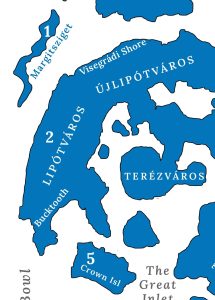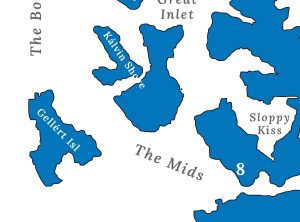


Margitsziget
This island was an island before the White Lake, which halved its original size. Too small to merit a bridge, in the years after the White Lake, it had become a locus of superstitious talk, the supposed daytime home of the manók, ancient creatures of legend used jokingly to explain Pest’s periodic seismic settling. The great early skater Gyöngyvér posed for a popular poster at the north end. Its occupation by the artist Janneyn Dasi did not so much dispel the superstition as attach it to her.
Gellért Island
A large section of the ancient Gellért Castle grounds survived the White Lake, high atop what are now sheer cliffs.
Crown Island
A small island in the mouth of the Great Inlet, connected by a filament bridge which makes it habitable. This main draw is the storied Blue Hookah, a bar built the ruins of the old Basilica of St István.
Kálvin Shoreline
Kálvin Shoreline is the west coast of the western island in a pair of islands surrounded by deep Lake. Abandoned before skating, it was linked to the filament bridges and became the largest launch on the Lake, effectively the only one newbies use. Most of the rest of the island and much of its eastern neighbor are now used for the processing of both skaters and of
Frankel Island
Frankel Island takes its name from the pre-White Lake street that forms the spine of this Lake-formed island. Its coast is too shallow for skating and like Géllert it has a sheer edge. Because it has been undisturbed and its land doesn’t accumulate carbon sand, it has vegetation, including trees.
Mushroom Island
Mushroom Island is uninhabited. Its northern shore is home to the mycoslop factory, which is wholly automated. A system of gondolas on filaments between the factory and a receiving station on Ferencváros runs twelve hours a day delivering mycoslop base.
Soroksári Island
Soroksári Island is also uninhabited. It has few accessible shorelines.